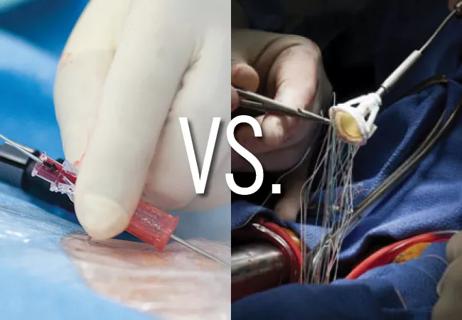Advertisement
From leadless pacing to drugging the microbiome for atherosclerosis

2015 was a busy year for many Cleveland Clinic Miller Family Heart & Vascular Institute staff who collaborated with internal and external colleagues to advance understanding and management of cardiovascular disease.
Advertisement
Cleveland Clinic is a non-profit academic medical center. Advertising on our site helps support our mission. We do not endorse non-Cleveland Clinic products or services. Policy
Some of their findings may alter treatment decisions. New devices they developed or tested promise to make interventional procedures and surgeries more effective. Some clinical trial results may be the final word, while others open the door for further study.
Below are snapshots of 15 of the most significant 2015 developments to which Cleveland Clinic cardiovascular specialists made key contributions. And here’s hoping the new year will prove just as fruitful.
A clinical trial of the CETP inhibitor evacetrapib was halted early when the drug failed to reduce the risk of heart attack, stroke and death despite its significant HDL-raising and LDL-lowering abilities. “These findings may influence our understanding of the mechanisms of lowering cardiovascular risk,” says cardiologist Steven Nissen, MD, who served as academic chairman of the study. Results of the study will be presented at ACC 2016, the American College of Cardiology’s 2016 Scientific Session.
Bioresorbable stent scaffolds are postulated to reduce device-related events by reducing inflammation, neoatherosclerosis and stent fracture. But in a head-to-head one-year comparison, an everolimus-eluting bioresorbable stent failed to show an advantage over a conventional everolimus-eluting stent, although it did prove noninferior. Interventional cardiologist Stephen G. Ellis, MD, principal investigator of the ABSORB III trial, remains hopeful that an advantage will appear over time as patients are followed. “If long-term results of this study are good, stent design will be revolutionized,” he says.
Advertisement
In post hoc analyses of early studies, PCSK9 inhibitors appear to reduce cardiac events without the side effects associated with statins. Cleveland Clinic is taking part in three major trials of these powerful LDL-lowering monoclonal antibodies, two of which received FDA approval in 2015. The multicenter GLAGOV trial, with Steven Nissen, MD, as study chair, is examining the effect of evolocumab on regression of coronary atherosclerosis as measured by IVUS. At ACC 2016, Dr. Nissen will be presenting results of the GAUSS-3 trial, which is studying the effectiveness of these drugs in statin-intolerant patients.
Transcatheter aortic valve replacement (TAVR) was developed as a less-invasive option for high-risk surgical patients. Cleveland Clinic cardiovascular surgeons and interventional cardiologists have participated in all substudies of the PARTNER trial of TAVR in various settings. Cardiothoracic surgeon Lars G. Svensson, MD, PhD, serves on the executive committee for this multipronged clinical study. Thirty-day results of the PARTNER 2A arm, which randomized patients at intermediate surgical risk to surgery or TAVR, were reported in 2015 and were “encouraging,” he says. One-year data will be presented at ACC 2016.
Cleveland Clinic electrophysiologists are active participants in pivotal studies of two percutaneously implanted leadless pacemaker devices designed to avoid complications associated with leads and pockets. Bruce Wilkoff, MD, and Khaldoun Tarakji, MD, MPH, are investigators in a study of Medtronic’s Micra™ device, while Daniel Cantillon, MD, is taking part in the LEADLESS II study of St. Jude Medical’s Nanostim™. Promising interim results from both studies were published in New England Journal of Medicine in 2015. If these results hold up over the full study periods, leadless devices may be the future of cardiac pacing.
After many years under FDA review, the WATCHMAN™ percutaneous left atrial appendage closure device was approved in 2015 for stroke risk reduction in patients with nonvalvular atrial fibrillation. Under the direction of cardiologists Oussama Wazni, MD, Walid Saliba, MD, Samir Kapadia, MD, and E. Murat Tuzcu, MD, Cleveland Clinic participated in two pivotal trials of the novel device, PROTECT AF and PREVAIL, whose aggregate data showed it to be noninferior to warfarin in reducing stroke from any cause.
Advertisement
Electrophysiologist Bruce Wilkoff, MD, led the 2015 launch of a 7,000-patient international randomized controlled trial of Medtronic’s TYRX™ antibacterial envelope. The WRAP-IT study is designed to evaluate the ability of this antibiotic-permeated, bioabsorbable pouch to reduce infections stemming from cardiovascular implantable electronic devices (CIEDs). “This trial will help reveal the true rate of CIED-related infections around the world and show whether this envelope reduces that rate and is cost-effective,” Dr. Wilkoff says.
In recent years cardiologist Stanley Hazen, MD, PhD, and colleagues have published pioneering studies showing how intestinal bacteria start a chain of events that turn choline from meat and eggs into a substance called TMAO that raises the risk of heart attack, stroke and death. They later found the same process plays a role in development of heart failure and chronic kidney disease. In 2015, they demonstrated that this gut microbial pathway can be targeted in a nonlethal way with a naturally occurring compound to lower TMAO levels and rates of atherosclerosis in mice. “This opens the door to exciting nutritional and interventional prospects,” Dr. Hazen says.
In 2015, cardiothoracic surgeon Jose Navia, MD, performed the first transcatheter mitral valve replacement using a prosthetic valve of his own design. His research was performed in the U.S., but the surgery was done in Chile. Planning for additional implantations of the device is underway.
Frustrated by malunions that often occur after closing the sternum with wire, Edward Soltesz, MD, MPH, and other cardiothoracic surgeons collaborated with Cleveland Clinic orthopaedic surgeons to develop a rigid closure device that perfectly aligns bone and eliminates motion. The resulting Grand Pre Sternal Closure System, the first such device designed specifically for the sternum, received FDA approval in January 2015.
Advertisement
2015 saw the first new drug approvals for heart failure in a decade, with most attention focusing on sacubitril/valsartan, the first available therapy to act by neprilysin inhibition. Approval of the agent was based on the 8,400-patient PARADIGM trial, for which cardiologist Randall Starling, MD, MPH, served as U.S. leader of the steering committee. “Sacubitril/valsartan offers incremental benefits beyond our existing treatments by reducing hospitalizations and mortality,” he notes.
Patients with severe heart failure and mitral regurgitation who are too sick for surgery may soon benefit from a new approach pioneered by cardiothoracic surgeon Lars G. Svensson, MD, PhD. He helped develop the investigational Mitra-Spacer™ device implanted transapically to provide a sealing surface for the valve leaflets without altering the anatomy. Now in clinical trials, with the first-in-human experience presented in 2015, the device has been shown to improve left ventricular function.
Vascular surgeon W. Michael Park, MD, continued to refine in 2015 a minimally invasive approach he has pioneered for removal of occluded stents in extensive aortoiliac occlusive disease. The procedure, developed as an alternative to aortobifemoral bypass grafting, involves performing remote endarterectomy with iliac balloon angioplasty and stenting supplemented by removal of obstructive plaque and occluded stents, leaving the native vessel intact. Patency is superior to that achieved with stents or PTFE graft bypasses.
Forget watchful waiting for severely regurgitant degenerative mitral valve (MV) disease. So concluded a comprehensive review published in 2015 of more than 5,900 MV repair procedures performed at Cleveland Clinic over a 26-year period. The analysis, led by cardiothoracic surgeon Joseph Sabik III, MD, found that repairing MV disease earlier and with less-invasive techniques allowed patients to benefit from repair before experiencing symptoms without any compromise in safety or efficacy.
An analysis of the largest series of patients undergoing surgery for disease of the ascending aorta or aortic arch led experts in Cleveland Clinic’s Aorta Center — including cardiothoracic surgeons Eric Roselli, MD, and Lars G. Svensson, MD, PhD, among others — to develop and publish the first classification of aortitis types and recommended treatments in early 2015.
Advertisement
Advertisement

Cleveland Clinic series supports its feasibility, especially with HeartMate 3

Questions remain following late mortality signal from a retrospective cohort study

TAVR explant demands multidisciplinary expertise

How two of our surgeons are working for care equity, greater representation in research and practice

Judicious application yields a 99.7% repair rate and 0.04% mortality

Studies reveal increased cardiac events, enhanced platelet reactivity and thrombotic potential

Large single-center series demonstrates safety and efficacy for extending procedure

Eminent clinician-researcher brings special expertise in nutritional interventions for heart failure